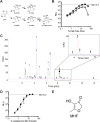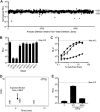Saccharomyces cerevisiae Requires CFF1 To Produce 4-Hydroxy-5-Methylfuran-3(2H)-One, a Mimic of the Bacterial Quorum-Sensing Autoinducer AI-2
- PMID: 33688008
- PMCID: PMC8092285
- DOI: 10.1128/mBio.03303-20
Saccharomyces cerevisiae Requires CFF1 To Produce 4-Hydroxy-5-Methylfuran-3(2H)-One, a Mimic of the Bacterial Quorum-Sensing Autoinducer AI-2
Abstract
Quorum sensing is a process of cell-to-cell communication that bacteria use to orchestrate collective behaviors. Quorum sensing depends on the production, release, and detection of extracellular signal molecules called autoinducers (AIs) that accumulate with increasing cell density. While most AIs are species specific, the AI called AI-2 is produced and detected by diverse bacterial species, and it mediates interspecies communication. We recently reported that mammalian cells produce an AI-2 mimic that can be detected by bacteria through the AI-2 receptor LuxP, potentially expanding the role of the AI-2 system to interdomain communication. Here, we describe a second molecule capable of interdomain signaling through LuxP, 4-hydroxy-5-methylfuran-3(2H)-one (MHF), that is produced by the yeast Saccharomyces cerevisiae Screening the S. cerevisiae deletion collection revealed Cff1p, a protein with no known role, to be required for MHF production. Cff1p is proposed to be an enzyme, with structural similarity to sugar isomerases and epimerases, and substitution at the putative catalytic residue eliminated MHF production in S. cerevisiae Sequence analysis uncovered Cff1p homologs in many species, primarily bacterial and fungal, but also viral, archaeal, and higher eukaryotic. Cff1p homologs from organisms from all domains can complement a cff1ΔS. cerevisiae mutant and restore MHF production. In all cases tested, the identified catalytic residue is conserved and required for MHF to be produced. These findings increase the scope of possibilities for interdomain interactions via AI-2 and AI-2 mimics, highlighting the breadth of molecules and organisms that could participate in quorum sensing.IMPORTANCE Quorum sensing is a cell-to-cell communication process that bacteria use to monitor local population density. Quorum sensing relies on extracellular signal molecules called autoinducers (AIs). One AI called AI-2 is broadly made by bacteria and used for interspecies communication. Here, we describe a eukaryotic AI-2 mimic, 4-hydroxy-5-methylfuran-3(2H)-one, (MHF), that is made by the yeast Saccharomyces cerevisiae, and we identify the Cff1p protein as essential for MHF production. Hundreds of viral, archaeal, bacterial, and eukaryotic organisms possess Cff1p homologs. This finding, combined with our results showing that homologs from all domains can replace S. cerevisiae Cff1p, suggests that like AI-2, MHF is widely produced. Our results expand the breadth of organisms that may participate in quorum-sensing-mediated interactions.
Keywords: autoinducer; collective behavior; interspecies; quorum sensing; signaling; yeast.
Copyright © 2021 Valastyan et al.
Figures





Similar articles
-
A Host-Produced Autoinducer-2 Mimic Activates Bacterial Quorum Sensing.Cell Host Microbe. 2016 Apr 13;19(4):470-80. doi: 10.1016/j.chom.2016.02.020. Epub 2016 Mar 17. Cell Host Microbe. 2016. PMID: 26996306 Free PMC article.
-
Quorum sensing in thermophiles: prevalence of autoinducer-2 system.BMC Microbiol. 2018 Jun 28;18(1):62. doi: 10.1186/s12866-018-1204-x. BMC Microbiol. 2018. PMID: 29954335 Free PMC article.
-
FRET-based biosensors for the detection and quantification of AI-2 class of quorum sensing compounds.Methods Mol Biol. 2011;692:31-46. doi: 10.1007/978-1-60761-971-0_3. Methods Mol Biol. 2011. PMID: 21031302
-
Autoinducer-2-based chemical communication in bacteria: complexities of interspecies signaling.Contrib Microbiol. 2009;16:18-32. doi: 10.1159/000219371. Epub 2009 Jun 2. Contrib Microbiol. 2009. PMID: 19494577 Free PMC article. Review.
-
Recent progresses on AI-2 bacterial quorum sensing inhibitors.Curr Med Chem. 2012;19(2):174-86. doi: 10.2174/092986712803414187. Curr Med Chem. 2012. PMID: 22320296 Review.
Cited by
-
A Geneticist Transcribing the Chemical Language of Bacteria.Isr J Chem. 2023 Jun;63(5-6):e202200079. doi: 10.1002/ijch.202200079. Epub 2022 Dec 1. Isr J Chem. 2023. PMID: 37469628 Free PMC article.
-
Cryo-EM structures of pentameric autoinducer-2 exporter from Escherichia coli reveal its transport mechanism.EMBO J. 2022 Sep 15;41(18):e109990. doi: 10.15252/embj.2021109990. Epub 2022 Jun 14. EMBO J. 2022. PMID: 35698912 Free PMC article.
-
Quorum sensing in bacteria: in silico protein analysis, ecophysiology, and reconstruction of their evolutionary history.BMC Genomics. 2024 May 3;25(1):441. doi: 10.1186/s12864-024-10355-6. BMC Genomics. 2024. PMID: 38702600 Free PMC article.
-
ArcB initiates quorum sensing to regulate T3SS in Vibrio alginolyticus by recognizing bacterial and host-derived autoinducer-2 as a kinase.Cell Commun Signal. 2025 May 28;23(1):245. doi: 10.1186/s12964-025-02258-0. Cell Commun Signal. 2025. PMID: 40437596 Free PMC article.
-
Less is more: the lack of autoinducer-2-dependent quorum sensing promotes competitive fitness of Escherichia coli strain 83972.Front Cell Infect Microbiol. 2025 Jul 2;15:1603759. doi: 10.3389/fcimb.2025.1603759. eCollection 2025. Front Cell Infect Microbiol. 2025. PMID: 40673006 Free PMC article.
References
Publication types
MeSH terms
Substances
Grants and funding
LinkOut - more resources
Full Text Sources
Other Literature Sources
Molecular Biology Databases

